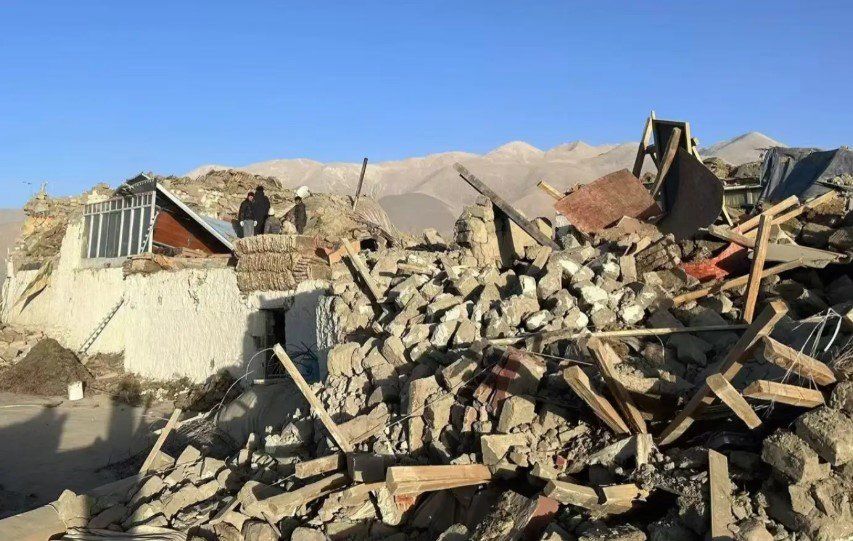The devastating quake struck at 9:05 am local time (01:05 GMT), with a magnitude of 6.8, as reported by the China Earthquake Networks Center. However, the United States Geological Survey pegged it at a magnitude of 7.1. Regardless of the exact measurement, the impact was undeniable, leaving thousands in distress as buildings crumbled and people rushed to find safety.
A Widespread Crisis
The tremor’s impact spread well beyond Tibet, reaching the neighboring regions of Nepal and northern India. In Nepal’s capital, Kathmandu, the quake was strongly felt, triggering fear as residents scrambled to evacuate buildings. The streets were flooded with people seeking refuge, while others tried in vain to contact loved ones.
In India, the earthquake’s aftershocks sent people in several northern states into a frenzy. The Bihar region, in particular, felt the brunt of the tremors. Areas like Patna, Sheohar, Munger, and Darbhanga experienced significant shaking, with some residents rushing out of their homes in alarm. Reports suggest that despite the panic, no substantial property damage was reported in India.

Tremors also reached other regions, including Katihar, Purnea, and Samastipur, further highlighting the widespread reach of the earthquake. It wasn’t just the primary quake that caused chaos—several aftershocks followed, deepening the fear and uncertainty.
Aftershocks and Relief Efforts
In the aftermath of the initial earthquake, the National Centre for Seismology (NCS) reported two more quakes that hit the region shortly after. The first aftershock, with a magnitude of 4.7, struck at 7:02 am, followed by another of magnitude 4.9 at 7:07 am. These continued tremors heightened the urgency of rescue operations.
The Chinese government quickly responded, dispatching disaster relief aid to the affected areas. Authorities sent cotton tents, quilts, and other supplies designed for high-altitude regions to assist the survivors. The relief effort is critical, especially given Tibet’s remote and rugged terrain.
In Tibet, the earthquake’s effects were catastrophic. Located on the Chinese side of Mount Everest, the region is home to about 62,000 people, many of whom are now grappling with the aftermath. The disaster has left entire communities searching for survivors amidst the rubble of collapsed buildings.
Emergency Operations on the Ground
Rescue operations are underway, with local authorities and aid agencies working tirelessly to find those trapped in the wreckage. However, the high-altitude conditions, along with ongoing aftershocks, are complicating the situation for first responders.
Despite these challenges, teams on the ground have been making significant efforts to reach the worst-hit areas. Local hospitals are overwhelmed with casualties, while volunteers continue to pour in to assist in any way they can.
It remains unclear how long it will take for authorities to fully assess the damage, but experts predict that the toll could rise further as more information comes in.
The Impact on Nepal and India
While Tibet bore the brunt of the earthquake, the tremors also affected neighboring countries, especially Nepal and India. In Kathmandu, local authorities issued warnings, urging residents to stay outdoors and avoid tall buildings. In India’s Bihar region, where people rushed to open spaces, the government has promised to provide assistance to any affected areas.
Despite the wide-reaching tremors, both Nepal and India have thus far reported no significant damage. The situation, however, remains fluid, and authorities are monitoring the situation closely for any potential aftershocks.
Key Areas Affected in India:
- Patna
- Madhubani
- Sheohar
- Munger
- Samastipur
- Muzaffarpur
- Katihar
- Darbhanga
- West Champaran
- East Champaran
Local authorities are preparing for possible disruptions to infrastructure and are advising residents to stay vigilant as additional aftershocks remain a concern.
A Geologically Active Region
Nepal, where the tremors were also felt, sits along a major fault line. The tectonic collision between the Indian and Eurasian plates has made the region seismically active for centuries. Earthquakes, though frequent, continue to pose significant risks to the populations living in the shadow of the Himalayas.
The region’s susceptibility to earthquakes is a harsh reminder of the powerful forces beneath the Earth’s surface. While modern engineering has improved the resilience of buildings and infrastructure, the destructive power of such natural events remains a serious threat to millions of people.
